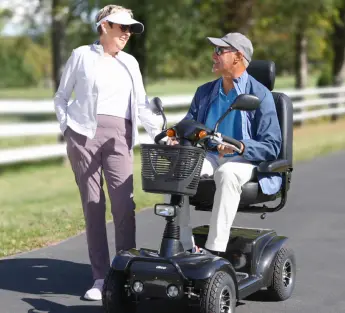Medicare, Medicaid and Private Insurance Billing at SpinLife
At SpinLife, our goal is to provide customers with total freedom to choose the products and services they want and deliver those products quickly and efficiently.
While it may seem obvious to go through insurance for your purchase, in many cases it will not be the most efficient option. We’ve provided the information below so you can make the right decision for you or your loved one.
| Self-Pay | Insurance | |
|---|---|---|
| Speed |
|
|
| Selection |
|
|
| Savings |
|
|
If you have questions about specific products or need assistance finding the right solution that fits within your budget, please call 800-850-0335 to speak with a SpinLife Product Expert. Our team may also be able to offer attractive financing options and discounts to help you manage the cost of your purchase.
If you still have questions surrounding insurance, please see below.
Options For Reimbursement
SpinLife is a division of Numotion, a national provider of durable medical equipment and mobility products. While SpinLife does not submit claims to Medicare, Medicaid or other health plans, Numotion has other operating divisions that can submit claims to health insurance providers.
A list of products and services Numotion assists with can be found here: https://www.numotion.com/products-services
If you are interested in obtaining coverage for your product via Medicare, Medicaid or private insurance, please call 800-500-9150 to reach one of Numotion’s product experts or visit www.Numotion.com/locations to find your local branch office.
Please note that the process for obtaining insurance coverage for eligible medical equipment can take several weeks or months, and typically requires an evaluation by a licensed physician along with a prescription and other medical documentation. The types of equipment available may also be limited depending on your health plan.
Frequently Asked Questions About Insurance Reimbursement
How does coverage typically work?
Medicare, Medicaid and other health insurance plans require a prescription from your treating physician or practitioner, along with supporting documentation that establishes your need. This may include office notes from a visit with your physician or practitioner; physical or occupational therapy evaluations; facility inpatient or outpatient records, home health therapy notes. Specific requirements may vary depending on the equipment prescribed. Prior Authorization may also be required – the prescription and documentation is obtained and sent to your health plan for a coverage decision before the equipment can be provided.
Medicare, Medicaid and other health plans also have provisions for paying for prescribed item(s) that may only allow rental (usually under a 10- or 13-month rent-to-purchase plan if there is a long-term need) rather than initial purchase. Some items are covered only as purchases. Again, the specifics vary depending on your health plan and the type of equipment in question.
How much will I be reimbursed through Medicare if I rent or purchase eligible products?
If you work with a Numotion location to obtain equipment or supplies using your Medicare benefits, that location will discuss with you any out-of-pocket financial responsibility. In general, Medicare pays about 80% of the Medicare-established allowable amount for that item, less any unmet annual deductible. In most cases, Numotion will file a claim to Medicare so that Medicare will pay Numotion directly, and you will be responsible for the copay and deductible, which might be paid for you if you have a supplemental or secondary insurance plan or also have Medicaid. In some cases, Numotion may only be able to file your Medicare claim non-assigned, which means that you will pay Numotion in full, and a claim will be filed so that Medicare will reimburse you a partial amount. In those cases, we can further explain how this works when we help you with a specific request.
What is the Medicare coverage process and criteria for manual wheelchairs, scooters and power wheelchairs?
Medicare covers manual wheelchairs, power-operated vehicles (scooters), and power wheelchairs as durable medical equipment (DME).
Medicare helps cover DME if:
- The doctor treating your condition submits a written order stating that you have a medical need for a wheelchair or scooter for use in your home.
- You have limited mobility and meet all these conditions:
- You have a health condition that causes significant difficulty moving around in your home.
- You are unable to do activities of daily living (like bathing, dressing, getting in or out of a bed or chair, or using the bathroom), even with the help of a cane, crutch, or walker.
- You are able to safely operate and get on and off the wheelchair or scooter, or have someone with you who is always available to help you safely use the device.
- Your doctor who is treating you from the condition that requires a wheelchair of scooter and your supplier are both enrolled in Medicare.
- You can use the equipment within your home (for example, it's not too big to fit through doorways in your home or blocked by floor surfaces or things in its path).
What is the Medicare reimbursement criteria for Manual Wheelchairs?
If you can’t use a cane or walker safely, but you have enough upper body strength or have someone who is available to help, you may qualify for a manual wheelchair. There has to be an established need for the wheelchair within the walls of your home.
What is the Medicare reimbursement criteria for Scooters?
If you can’t use a cane or walker, and can’t operate a manual wheelchair, you may qualify for a power-operated scooter if you can safely get in and out of it and are strong enough to sit up and safely operate the controls. There has to be an established need for the scooter within the walls of your home.
What is the Medicare reimbursement criteria for Power Wheelchairs?
If you can’t use a manual wheelchair in your home, and if you don’t qualify for a power-operated scooter because you aren’t strong enough to sit up or to work the scooter controls safely, you may qualify for a power wheelchair. You must have a medical need in your home for Medicare to cover a power wheelchair or scooter. Medicare won’t cover this equipment if it will be used mainly for leisure or recreational activities, or if it is only needed to move around outside your home.
What is the Medicare reimbursement criteria for Lift Chairs?
For Lift Chairs, Medicare only covers the seat-lift mechanism, not the actual chair itself. This typically makes the actual amount of the reimbursement quite low depending on the state in which the beneficiary is located and if the coverage criteria are met.
For coverage criteria to be met, you must receive a certificate of medical necessity. The certificate will not be issued unless you have arthritis of the hip or knee or a neuromuscular disorder. Additionally, the certificate will not be issued if you are able to stand from a seated position.
What is the Medicare reimbursement criteria for Ramps?
Insurance coverage for ramps is rare and minimal. Though as for all decisions, you should consult with your insurance for the best and most up to date information.
What is the Medicare reimbursement criteria for Hospital Beds?
Like wheelchairs, hospital beds can occasionally be covered by Medicare. However, they will typically require specific conditions to meet the criteria of it being a medically necessary device.
What is the Medicare reimbursement criteria for Wheelchair Cushions?
For wheelchair cushions, Medicare first must approve and pay for the wheelchair on which the cushion will be used. There are several types of cushions available for general use, skin protection, positioning, etc., and coverage is dependent on having a specific qualified diagnosis.





 Contact Us
Contact Us
 M-F 9am - 5pm ET
M-F 9am - 5pm ET
 Request parts
Request parts Request Service
Request Service